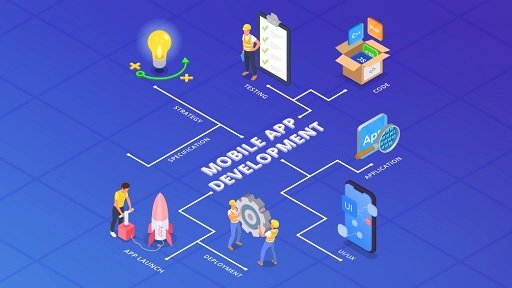Mobile apps have transformed how we work, play, and interact in a digital world. These versatile tools have become essential to modern life, meeting many needs. Custom mobile app development leads this technological wave, allowing businesses and individuals to create customized solutions. This comprehensive guide guides you through the complex process of developing an innovative app idea. Each phase is broken down into actionable steps, from ideation and market research to design, development, testing, and post-launch maintenance. This guide gives you the skills to create a mobile app that exceeds user expectations in today’s dynamic digital landscape.
Steps for Custom Mobile App Development
Step 1: Ideation and Conceptualization
Every successful mobile app starts with a good idea. First, brainstorm a problem or need your app can solve. Market research, target audience understanding, and how your app can stand out from competitors. After you have a clear idea, create a rough sketch of the app’s features and functions.
Step 2: Market Research
Validating your idea and finding gaps and opportunities requires thorough market research. Examine niche apps’ strengths and weaknesses. Custom mobile app development services use trends, user preferences, and pain points to improve your app’s concept. Potential users’ insights and surveys can help shape your app.
Step 3: Define the Scope
App development project scope must be defined to avoid scope creep and manage expectations. Create a detailed project plan for your app’s features, functions, and user interactions. Break down the development process into milestones to track progress and allocate resources.
Step 4: Wireframing and Design
Create a visual representation of your idea. Use wireframes and mock-ups to design the UI and UX. This step will visualize the app’s layout, navigation, and design aesthetics. Maintain user-centric design principles when working with designers to create a smooth and intuitive user experience.
Step 5: Technical Feasibility Assessment
Before developing, evaluate your app’s features and functions’ technical viability. Decide whether your app will support iOS, Android, or both, and choose development tools and programming languages. Develop the best architecture and technology stack for your app with developers.
Step 6: Development
The development phase turns design and technical specs into a working app. Native (platform-specific) or cross-platform development frameworks depend on your app’s complexity (like React Native or Flutter). The development team and stakeholders must communicate regularly to resolve issues and keep the project on track.
Step 7: Testing
You need thorough testing to ensure your app is bug-free and user-friendly. Perform functional, usability, and compatibility testing to ensure the app works properly on all devices and operating systems. Before moving on, get the tester’s feedback and make adjustments.
Step 8: Beta Testing
Beta-test your app with a select group before releasing it. This phase identifies last-minute issues, gathers user feedback, and optimizes the app. Beta testing helps you fix bugs and satisfy users.
Step 9: Deployment
Your app is ready for deployment after testing and refining. Prepare to release your app-on-app stores (Apple App Store and Google Play Store). For a smooth submission, follow each platform’s guidelines. App store optimization (ASO) boosts visibility and attracts users.
Step 10: Post-Launch and Maintenance
The app’s launch is just the beginning. Maintaining user engagement and meeting changing needs requires continuous improvement. Track user feedback, app performance, and insights with analytics tools. Update your app regularly to add features, fix bugs, and support new devices and operating systems.
Step 11: Marketing and Promotion
A great app is only half the battle—effective marketing and promotion are needed to attract users and drive downloads. Create an integrated marketing strategy that includes social media, influencer partnerships, content, and paid advertising. Use your app’s USPs and benefits to create a compelling message for your target audience.
Step 12: Scaling and Future Development
As your app gains traction and users, planning for scalability is important. Android and iOS application development services analyze user behavior, performance metrics, and growth patterns to anticipate future demands. Prepare for scaling by optimizing your app’s infrastructure, backend systems, and database architecture. Additionally, consider introducing new features and functionalities to keep your app relevant and engaging for a wider audience.
Conclusion
From concept to a fully functional and successful custom mobile app is complicated in the fast-changing mobile technology landscape. This step-by-step guide emphasizes careful creativity, planning, and iteration. From conception and design to development, testing, and post-launch maintenance, your app adapts to user needs and market trends. User engagement from marketing and user feedback boosts app recognition and adoption. Remember that app development is fluid; staying in touch with user preferences and new technologies ensures your app’s longevity and relevance. Following this guide, you can start a transformative mobile app development journey that could change countless users’ digital experiences.
